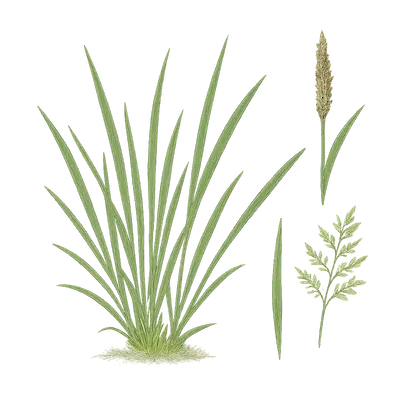Grass Pollen
Description
Grasses are a diverse group of plants found worldwide, encompassing thousands of species. They play a crucial role in ecosystems, serving as a primary food source for many animals and contributing to soil stability. However, the pollen produced by grasses is a common allergen responsible for seasonal allergic rhinitis, commonly known as hay fever.

Allergy Symptoms
Exposure to grass pollen can trigger various allergic reactions, including:
- Nasal symptoms: Sneezing, runny or congested nose.
- Ocular symptoms: Itchy, watery, and red eyes.
- Respiratory issues: Coughing, wheezing, and exacerbation of asthma symptoms.
- Skin reactions: Itchy skin or hives in some individuals.
Approximately 95% of hay fever sufferers in the UK are allergic to grass pollen.
Typical Pollination Period
The pollination period for grasses varies by region:
- United Kingdom: Grass pollen is mostly present in the summer months, in both ornamental grasses, and in lawns and meadows.
- Europe: The grass pollen season typically spans from May to July, though this can vary depending on altitude and geographical location.
- United States: Grass pollen season generally occurs in late spring to early summer, varying by region.
Geographic Distribution
Grasses are ubiquitous and found in nearly every habitat worldwide, including:
- Urban areas: Lawns, parks, and sports fields.
- Rural areas: Meadows, pastures, and agricultural lands.
- Natural landscapes: Prairies, savannas, and grasslands.
Tips for Reducing Exposure and Managing Allergies
- Monitor pollen forecasts: Stay informed about local grass pollen levels during the pollination season.
- Limit outdoor activities: Especially on high pollen count days and during early morning hours when pollen levels are typically higher.
- Protect indoor environments: Keep windows closed and use air purifiers to reduce indoor pollen exposure.
- Personal hygiene: Shower and change clothes after being outdoors to remove pollen.
- Lawn maintenance: Regularly mow lawns to prevent grasses from flowering and producing pollen.
- Medication: Use antihistamines, nasal corticosteroids, or other allergy medications as recommended by a healthcare professional.
- Consult an allergist: For persistent or severe symptoms, seek advice from an allergist who may recommend immunotherapy or other treatments.